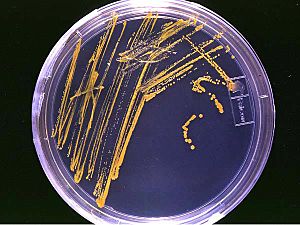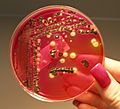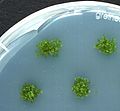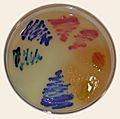Growth medium facts for kids
Imagine a special food that scientists use to help tiny living things grow! A growth medium (also called a culture medium) is like a special meal, either a solid jelly or a liquid soup. It's full of nutrients that help microorganisms (like bacteria or fungi), cells from plants or animals, or even small plants like moss grow in a lab. Scientists use different types of growth media for different kinds of cells.
There are many kinds of growth media used in science. Here are some of the main types:
Contents
Types of Growth Media
Defined vs. Undefined Media
Some growth media are like a secret recipe where you know every single ingredient and its exact amount. These are called defined media. Scientists know exactly what chemicals are in them.
Other media are like a general stew; you know the main ingredients, but not the exact amounts of every tiny part. These are undefined media. They are often made from natural products like yeast extract.
Selective Media
Imagine a special food that only allows certain people to eat it. Selective media work like that! They have special ingredients, like an antibiotic, that stop most microorganisms from growing. Only the ones that are strong enough to resist the antibiotic will grow. This helps scientists find specific types of germs.
Differential Media
Differential media help scientists tell different types of microorganisms apart, even if they are growing on the same plate. These media often contain special dyes or chemicals. Different germs will react differently to these chemicals, causing them to change color or look different. This makes it easy to identify them.
Transport Media
Sometimes, scientists need to move microorganisms from one place to another without them growing too much. Transport media are designed for this. They have just enough nutrients to keep the organisms alive and healthy during travel, but not enough to make them multiply quickly.
Enriched Media
Enriched media are like super-meals for microorganisms! They contain extra amino acids and other important building blocks. Scientists use these media to grow a wide variety of organisms from a sample, especially if the organisms are picky eaters or are present in small numbers.
Images for kids
-
US Food and Drug Administration scientist tests for Salmonella
-
A culture of salmonella bacteria
-
Physcomitrella patens plants growing axenically on agar plates (Petri dish, 9 cm diameter)
-
Blood-free, charcoal-based selective medium agar (CSM) for isolation of Campylobacter
-
Blood agar plates are often used to diagnose infection. On the right is a positive Staphylococcus culture; on the left is a positive Streptococcus culture.
See also
 In Spanish: Medio de cultivo para niños
In Spanish: Medio de cultivo para niños









